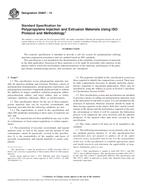Wir benötigen Ihre Einwilligung zur Verwendung der einzelnen Daten, damit Sie unter anderem Informationen zu Ihren Interessen einsehen können. Klicken Sie auf "OK", um Ihre Zustimmung zu erteilen.
ASTM D5857-14
Standard Specification for Polypropylene Injection and Extrusion Materials Using ISO Protocol and Methodology
Automatische name übersetzung:
Standard-Spezifikation für Polypropylen Injection und die Extrusion unter Verwendung eines ISO-Protokoll und Methodik
NORM herausgegeben am 1.4.2014
Informationen über die Norm:
Bezeichnung normen: ASTM D5857-14
Anmerkung: UNGÜLTIG
Ausgabedatum normen: 1.4.2014
SKU: NS-32825
Zahl der Seiten: 20
Gewicht ca.: 60 g (0.13 Pfund)
Land: Amerikanische technische Norm
Kategorie: Technische Normen ASTM
Die Annotation des Normtextes ASTM D5857-14 :
Keywords:
injection and extrusion materials, polypropylene, recycled, ICS Number Code 83.040.20 (Rubber compounding ingredients)
Ergänzende Informationen
| 1. Scope | ||||||||||||||||||
|
1.1 This specification covers polypropylene materials suitable for injection molding and extrusion. Polymers consist of polypropylene homopolymers, polypropylene copolymers, and polypropylene-elastomer compounds produced with or without the addition of impact modifiers (ethylene-propylene rubber, polyisobutylene rubber, and butyl rubber, and so forth), colorants, stabilizers, lubricants, fillers, or reinforcements. 1.2 This specification allows for the use of those polypropylene materials that can be recycled, reconstituted, and reground, provided that the following conditions are met: 1.2.1 The requirements as stated in this specification and other ISO guidelines pertaining to these types of materials are met, and 1.2.2 The material has not been modified in any way to alter its conformance to food contact regulations or similar requirements. 1.3 The proportions of recycled, reconstituted, and regrind material used, as well as the nature and the amount of any contaminant, cannot be practically covered in this specification. It is the responsibility of the supplier and buyer of recycled, reconstituted, and regrind materials to ensure compliance. 1.4 The properties included in this classification system are those required to identify the compositions covered. There may be other requirements necessary to identify particular characteristics important to specialized applications. These may be specified by using the suffixes as given in Section 1.5 This classification system and specification are intended to provide a means of calling out polypropylene materials used in the fabrication of end items or parts. It is not intended for the selection of materials. Material selection should be made by those having expertise in the plastic field after careful consideration of the design and the performance required of the part, the environment to which it will be exposed, the fabrication process to be employed, the costs involved, and the inherent properties of the material other than those covered by this specification. 1.6 The values stated in SI units are to be regarded as the standard. 1.7 The following precautionary caveat pertains only to the test methods portion, Section 13, of this specification: This specification does not purport to address all of the safety concerns, if any, associated with its use. It is the responsibility of the user of this specification to establish appropriate safety and health practices and determine the applicability of regulatory limitations prior to use.
|
|
Standard Test Method for High Speed Puncture Properties of Plastics Using Load and Displacement Sensors
|
|
Standard Guide for Selection of Specimens and Test Parameters for International Commerce (Withdrawn 2000)
|
|
Standard Terminology for Abbreviated Terms Relating to Plastics (Withdrawn 2024)
|
|
Standard Terminology Relating to Plastics
|
|
Standard Classification System for Specifying Plastic Materials
|
|
Standard Practice for Using Significant Digits in Test Data to Determine Conformance with Specifications
|
|
Standard Practice for Packaging/Packing of Plastics
|
|
Standard Guide for Waste Reduction, Resource Recovery, and Use of Recycled Polymeric Materials and Products (Withdrawn 2015)
|
|
Standard Practice for Conditioning Plastics for Testing |
Empfehlungen:
Aktualisierung der Gesetze
Wollen Sie sich sicher sein, dass Sie nur die gültigen technischen Vorschriften verwenden?
Wir bieten Ihnen Lösungen, damit Sie immer nur die gültigen (aktuellen) legislativen Vorschriften verwenden könnten.
Brauchen Sie mehr Informationen? Sehen Sie sich diese Seite an.




 Cookies
Cookies
